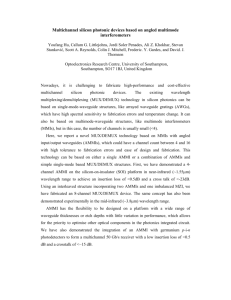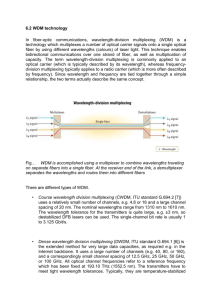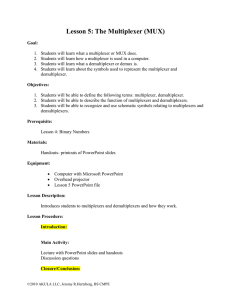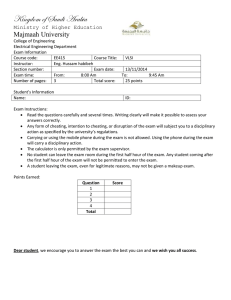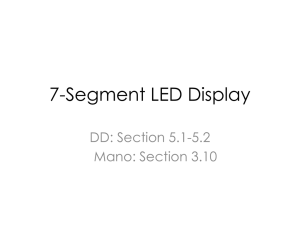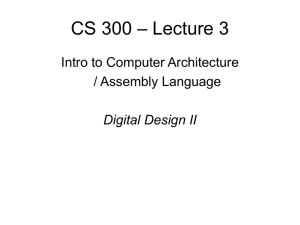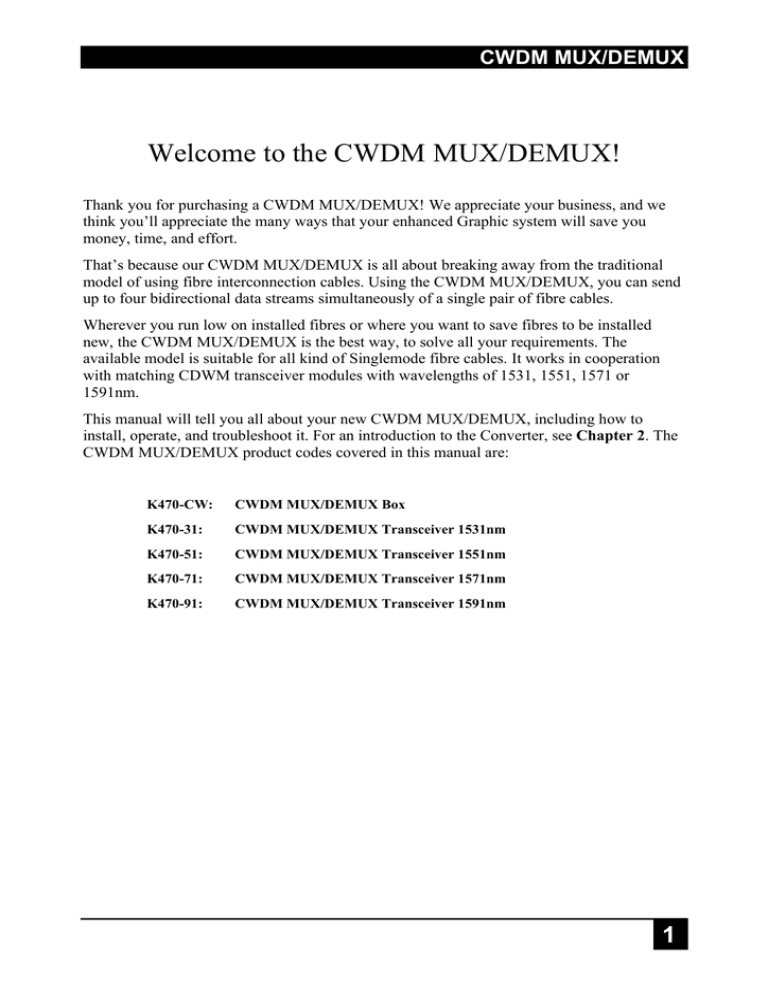
CWDM MUX/DEMUX
Welcome to the CWDM MUX/DEMUX!
Thank you for purchasing a CWDM MUX/DEMUX! We appreciate your business, and we
think you’ll appreciate the many ways that your enhanced Graphic system will save you
money, time, and effort.
That’s because our CWDM MUX/DEMUX is all about breaking away from the traditional
model of using fibre interconnection cables. Using the CWDM MUX/DEMUX, you can send
up to four bidirectional data streams simultaneously of a single pair of fibre cables.
Wherever you run low on installed fibres or where you want to save fibres to be installed
new, the CWDM MUX/DEMUX is the best way, to solve all your requirements. The
available model is suitable for all kind of Singlemode fibre cables. It works in cooperation
with matching CDWM transceiver modules with wavelengths of 1531, 1551, 1571 or
1591nm.
This manual will tell you all about your new CWDM MUX/DEMUX, including how to
install, operate, and troubleshoot it. For an introduction to the Converter, see Chapter 2. The
CWDM MUX/DEMUX product codes covered in this manual are:
K470-CW:
CWDM MUX/DEMUX Box
K470-31:
CWDM MUX/DEMUX Transceiver 1531nm
K470-51:
CWDM MUX/DEMUX Transceiver 1551nm
K470-71:
CWDM MUX/DEMUX Transceiver 1571nm
K470-91:
CWDM MUX/DEMUX Transceiver 1591nm
1
CWDM MUX/DEMUX
Copyrights and Trademarks
©2009. All rights reserved. This information may not be reproduced in any manner without
the prior written consent of the manufacturer.
Information in this document is subject to change without notice and the manufacturer shall
not be liable for any direct, indirect, special, incidental or consequential damages in
connection with the use of this material.
All trademark and trade names mentioned in this document are acknowledged to be the
property of their respective owners.
Disclaimer
While every precaution has been taken in the preparation of this manual, the manufacturer
assumes no responsibility for errors or omissions. Neither does the manufacturer assume any
liability for damages resulting from the use of the information contained herein. The
manufacturer reserves the right to change the specifications, functions, or circuitry of the
product without notice.
The manufacturer cannot accept liability for damage due to misuse of the product or due to
any other circumstances outside the manufacturer’s control (whether environmental or
installation related). The manufacturer shall not be responsible for any loss, damage, or injury
arising directly, indirectly, or consequently from the use of this product.
Cautions and Notes
The following symbols are used in this guide:
CAUTION: This indicates an important operating instruction
that should be followed to avoid any potential damage to
hardware or property, loss of data, or personal injury.
NOTE. This indicates important information to help you make the best use of
this product.
2
EMPTY PAGE
.
3
CWDM MUX/DEMUX
Safety Precautions and Installation Guidelines
To ensure reliable and safe long-term operation, please note the following installation
guidelines:
•
Only use in dry, indoor environments.
•
The Remote unit, Local unit and any power supplies can get warm. Do not locate them
in an enclosed space without any airflow.
•
Do not place a power supplies directly on top of a unit.
•
Do not obstruct a unit’s ventilation existing holes.
To safeguard against personal injury and avoid possible
damage to equipment or property, please observe the
following:
4
•
Only use power supplies originally supplied with the
product or manufacturer-approved replacements. Do not
attempt to dismantle or repair any power supply. Do not
use a power supply if it appears to be defective or has a
damaged case.
•
Connect all power supplies to grounded outlets. In each
case, ensure that the ground connection is maintained
from the outlet socket through to the power supply’s AC
power input.
•
Do not attempt to modify or repair this product, or make
a connection from the interconnection link interface to
any other products, especially telecommunications or
network equipment.
TABLE OF CONTENTS
Contents
1. Quick Setup
6
2. Overview
7
2.1
2.2
2.3
2.4
2.5
2.6
Introduction
Glossary
Example of a CWDM MUX/DEMUX System
Features
Product Range
Compatibility
3. Installation
3.1
3.2
3.3
3.4
Package Contents
Interconnection Cable Requirements
System Setup
Diagnostics
7
7
8
9
9
9
10
10
10
11
11
4. Service Setup
12
5. Troubleshooting
12
Appendix A: Example Applications
13
Appendix B: Rack Mount Options
14
Appendix C: Calling Technical Support
16
Appendix D: Specifications
17
5
CWDM MUX/DEMUX
1. Quick Setup
This section briefly describes how to install your CWDM MUX/DEMUX system. Unless you
are an experienced user, we recommend that you follow the full procedures described in the
rest of this manual.
Install system
1.
2.
3.
4.
Install the CWDM MUX/DEMUX Transceivers in the Local and Remote
units. Each wavelength must not appear more than once in the system.
Device pairs must carry transceivers with the same wavelength.
Connect interconnection cables from Remote/Local unit to CWDM
MUX/DEMUX Box – please mind that you connect the transceivers to the
matching port at the CWDM MUX/DEMUX Box.
Connect Local and Remote CWDM MUX/DEMUX units with matching
interconnection cable (Singlemode Fiber).
Power up the system.
NO
Link
established?
Check the Fiber cables, and Fiber
connectors
Check, whether the Transceivers
are plugged into the correct ports
1531 in 1531 a.s.o
YES
Done
6
OVERVIEW
2.
Overview
2.1
Introduction
A CWDM MUX/DEMUX is used, to reduce the number of required fibres for a number of
independent data links. The CWDM MUX/DEMUX Box mixes the signals in different
wavelengths onto a single fiber and splits it again into the original signals at the end of a link.
A basic CWDM MUX/DEMUX system comprises a Local (KVM-Extender) unit, the
CWDM MUX/DEMUX Box and a Remote (KVM-Extender) unit.
2.2
Glossary
The following terms are used in this guide:
Fiber
Singlemode or Multimode fiber cable.
Singlemode
9µ Singlemode-fiber cable
Multimode
62,5µ Multimode- or
50µ Multimode-fiber cable
KVM
Keyboard, Video and Mouse.
Console
Keyboard, Mouse and Monitor
Dual Access
A system allowing connection of Local and Remote user consoles.
Single-Head
An extender system that supports one monitor + Keyboard/Mouse
Dual-Head
An extender system that supports two monitors + Keyboard/Mouse
DVI
Digital Video standard, installed by Digital Display Working Group
(www.ddwg.org) R, G, B, CLOCK in a data stream with up to
3x 1,6 Gbit/sec. Signals are TMDS Level.
PSU
The desktop power supply connected to the Local/Remote unit.
HID
Human Interface Devices are units, which are used for human access
to the CPU. They are a USB-device class of its own (e.g. Memory
Devices etc.). Besides of keyboard and mouse also touch screen, light
pen, fingerprint sensor, graphic tablets etc. are HID devices.
CWDM
Coarse Wavelength Division Multiplexing is a technology which
multiplexes multiple optical carrier signals on a single optical fiber by
using different wavelengths (colours) of laser light to carry different
signals.
7
CWDM MUX/DEMUX
2.3
Example of a CWDM MUX/DEMUX System
CWDM MUX/DEMUX system (example)
8
OVERVIEW
2.4
Features
The CWDM MUX/DEMUX offers the following features:
•
Support for up to 4 data streams
•
Support for 9µ Singlemode fibers
•
NO p.s.u. required
•
Small footprint chassis.
•
Rack mount options available.
2.5
Product Range
CWDM MUX/DEMUX Box
K470-CW
CWDM Multiplex/Demultiplex Device Box Pair
K470-31
CWDM MUX/DEMUX Transceiver 1531nm
K470-51
CWDM MUX/DEMUX Transceiver 1551nm
K470-71
CWDM MUX/DEMUX Transceiver 1571nm
K470-91
CWDM MUX/DEMUX Transceiver 1591nm
Accessories
455-8G
2.6
19”/1HE Rack mount- Kit to mount up to 2 CWDM
MUX/DEMUX devices
Compatibility
Interface Compatibility
•
Singlemode Fiber Data: The system works barely optical. The incoming light signals
are multiplexed onto the Singlemode Fiber and de-multiplexed at the remote end.
9
CWDM MUX/DEMUX
3. Installation
For first-time users, we recommend that you carry out a test placement, confined to a single
room, before commencing full installation. This will allow you to identify and solve any
cabling problems, and experiment with the KVM extender system more conveniently.
3.1 Package Contents
You should receive the following items in your extender package (all types):
•
CWDM MUX/DEMUX- pair (Local Unit + Remote Unit which are identical)
•
User manual (Quick Setup)
If anything is missing, please contact Technical Support (see Appendix F – Calling
Technical Support).
3.2 Interconnection Cable Requirements
To connect the Local and Remote units to the CWDM MUX/DEMUX box and to
interconnect the both CWDM MUX/DEMUX Boxes you will need:
•
Fiber Cable: Two strands of fiber are required for connecting the Local and Remote
units to the CWDM MUX/DEMUX box and to interconnect the both CWDM
MUX/DEMUX Boxes
•
Recommended cables:
Singlemode type 9/125µ
10
allowed distance app. 40km (approx. 25 miles)
INSTALLATION
3.3 System Setup
To install your CWDM MUX/DEMUX –system:
1.
Switch off all devices.
2.
Install the CWDM MUX/DEMUX Transceivers in the Local and Remote units. Each
wavelength must not appear more than once in the system. Device pairs must carry
transceivers with the same wavelength.
Each wavelength (1531, 1551, 1571, 1591nm) must not be used more than
once at each side! For 4 links, please us 4 different wavelengths, for 3 – 3
different wavelengths and for 2- 2 different wavelengths.
Each transceiver will work only at the appropriate port
The data will always flow between devices with the same wavelengths
3.
Connect interconnection cables from Remote/Local unit to CWDM MUX/DEMUX Box
– please mind that you connect the transceivers to the matching port at the CWDM
MUX/DEMUX Box.
4.
Connect Local and Remote CWDM MUX/DEMUX units with matching interconnection
cable (Singlemode Fiber).
5.
Power up the system.
Port
1531nm
Port
1551nm
Port
1571nm
Port
1591nm
Interconnect
CWDM MUX/DEMUX Type K470-CW Unit
3.4
Diagnostics
There are no diagnostic possibilities at the CWDM MUX/DEMUX box. Please use the
diagnostic possibilities of the attached units
11
CWDM MUX/DEMUX
4.
Service Setup
There are no service possibilities at the CWDM MUX/DEMUX box.
5.
Troubleshooting
There isn’t a data link.
Check the attached devices by directly connecting Local to Remote unit using a
short fiber cable..
Check that each wavelength does not occurs more than once at the local side and at
the remote side.
Check that the transceivers are routed to the correct ports at the CWDM
MUX/DEMUX box.
12
APPENDIX A: EXAMPLE APPLICATIONS
Appendix A: Example Applications
•
CWDM MUX/DEMUX system.
13
CWDM MUX/DEMUX
Appendix B: Rack Mount Options
CWDM MUX/DEMUX units can be mounted in a 19” rack using the mounting kit
Mounting Instruction Rackmount-Kit 455-8G
Using the Rackmount-Kit 455-8G, up to 4 devices of the device size 103x143x42mm (DualHead Devices) can be mounted into a 19“-Server Rack. The Rackmount Kit requires 1U Rack
space. Blind plates (in the list of parts delivered) allow covering unused device positions.
Rackmount-Kit 455-8G – List of parts delivered:
base plate
8 pieces spacer – M2,5x2
3 pieces blind plate
8 pieces M2,5x5 Philips type
countersunk screws
The CWDM MUX/DEMUX units require the rack space of two regular
devices. So far you can mount up to 2 CWDM MUX/DEMUX units into a
1U rack space.
Mounting instruction:
•
Align the holes on the base plate with the vacant screw holes on the base of the device.
•
Fasten the base of the unit to the plate of the mounting kit
Only use the supplied, short screws, to prevent damages on
the PCB’s
•
14
Close the remaining gaps with blanking plates.
APPENDIX B: RACK MOUNT OPTIONS
The Rackmount-Kit 455-8G allows, mounting a different count of devices (1…4 pieces):
In the most left position you can mount a rack mountable p.s.u. type 455-PS instead of a
regular device. This p.s.u. is capable to power up to three devices.
15
CWDM MUX/DEMUX
Appendix C: Calling Technical Support
If you determine that your CWDM MUX/DEMUX unit is malfunctioning, do not attempt to
alter or repair it. It contains no user-serviceable parts. Contact Technical Support at. your
local dealer
Before you do, make a record of the history of the problem. We will be able to provide more
efficient and accurate assistance if you have a complete description, including:
•
The nature and duration of the problem.
•
When the problem occurs.
•
The components involved in the problem—that is, what type of computers, what type of
keyboard, brand of mouse, make and model of monitor, type and make of cable, etc.
•
Any particular application that, when used, appears to create the problem or make it
worse.
•
The results of any testing you’ve already done.
To solve some problems, it might be necessary to upgrade the Extender’s firmware. If this
turns out to be the case for your difficulty, our Technical Support technicians will arrange for
you to receive the new firmware and will tell you how to install it.
Shipping and Packaging
If you need to transport or ship your CWDM MUX/DEMUX unit:
•
Package it carefully. We recommend that you use the original container.
•
If you are shipping it for repair, please include the Unit’s external power supplies. If you
are returning it, please include everything you received with it. Before you ship the
Extender back to your dealer for repair or return, contact him to get a Return
Authorization (RA) number.
16
APPENDIX D: SPECIFICATIONS
Appendix D: Specifications
Power supply
NO Power required
Interface
Fiber Connectors
LC duplex
Maximum Length of Interconnection Cable (Fiber - LC Connectors)
Singlemode 9 μm
40.000m (approx. 25 miles)
Size and Shipping Weight
CWDM MUX/DEMUX units
206 x 143 x 42mm (8”x5.6”x1.7”) (2 Geräte)
Weight Local/Remote Unit: 1,0kg (2.2lb)
Shipping box
460x250x120mm (18.1”x9,8”x4,7”)
Weight: 1,6 kg (3.5lb)
Environmental
Operating Temperature
41 to 113°F (5 to 45 °C)
Storage Temperature
-13 to 140°F (-25 to 60 °C)
Relative Humidity
max. 80% non-condensing
17
NOTES

